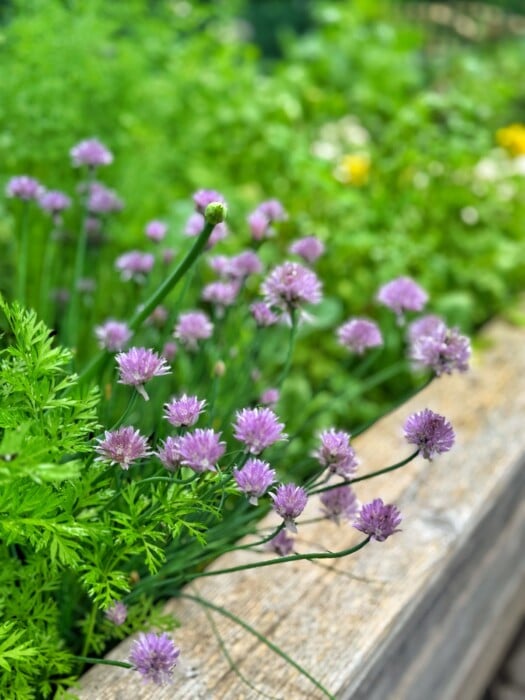Are you interested in growing dahlias but don’t know where to start? Learn how to grow and care for stunning dahlia flowers with this easy-to-follow guide. From planting to care, we’ll cover everything you need to know.
Dahlias are a total showstopper, boasting gorgeous colors and diverse shapes. While they sometimes get a reputation for being difficult, that couldn’t be further from the truth! This beginner’s guide will demystify the process and equip you with everything you need to successfully cultivate these stunning blooms.
Although I typically focus on easy-care plants, dahlias are a beloved exception. They require a bit more effort, but the rewards are immense. Are you up for the challenge?
From selecting the perfect varieties to planting, nurturing, and overwintering your tubers, I’ll walk you through each step, ensuring your dahlia garden is the envy of the neighborhood. These versatile flowers, ranging from tiny pompons to dinnerplate-sized blooms, not only dazzle in the garden but also create incredible flower arrangements.
Let’s dive in and learn everything you need to know about dahlia care. Your beautiful dahlia garden starts now!
(Posts on stacyling.com may contain affiliate links. Click HERE for full disclosure.)
Understanding Dahlia Flowers
Dahlias are beautiful flowering plants that require some care to thrive and produce their vibrant blooms. They are the highlight of the late summer garden and are worth growing if you are up to the task of caring for them.
Dahlias are vibrant, diverse perennials known for their stunning, colorful blooms that can brighten any garden from mid-summer to fall. Suitable for hardiness zones 7-10 and are considered tender in colder climates. They vary greatly in height, from compact 1-foot varieties to towering 6-foot plants, making them truly versatile for various garden settings.
- Common Name: Dahlia
- Plant Type: Perennial (tender)
- Hardiness Zone: 7-10
- Light: Full sun
- Soil Requirements: Well-drained, fertile, slightly acidic
- Height: 1-6 feet
- Width: 1-3 feet
- Flower Color: Various colors (red, pink, yellow, white, purple, etc.)
- Foliage Color: Green
- Bloom Time: Mid-summer to fall


Are Dahlias Perennials?
Dahlias are tender perennials that must be lifted out of the ground in order to survive in colder climates (like mine gardening zone 6a) or treated as an annual. In most cases, home gardeners buy them as tubers, so this can get very expensive if you buy them from year to year.
How Tall Do Dahlia Flowers Grow?
Depending on the variety, dahlias range in size. Some will need to be supported, and others will not (see more about staking below). But in general, dahlia flowers range in size anywhere from 1-6 feet tall to 1-2 feet wide.
When Do Dahlia Flowers Bloom?
In general, dahlias bloom from about midsummer to the first frost. But I planted mine a little earlier this year, and they started blooming in early summer. As an aside, I generally don’t recommend planting dahlia bulbs earlier than you should, but we had the mildest winter here, there wasn’t a frost in sight, and I just went for it. It was a huge risk, but I watched the weather and was prepared to cover them if necessary.

Why Grow Dahlias
Despite them not being low-maintenance plants, dahlia flowers are a popular choice among gardeners for good reason.
- Stunning Variety: From delicate to dinner-plate sized, dahlias offer a breathtaking range of colors, shapes, and sizes. To learn more about the different dahlia varieties, check out my post here that shares my favorites.
- Extended Bloom Time: Enjoy vibrant flowers from mid-summer until the first frost.
- Exceptional Cut Flowers: Create show-stopping bouquets and arrangements with their long-lasting blooms.
- Pollinator Friendly: Attract bees, butterflies, and hummingbirds, supporting a healthy garden ecosystem.
- Versatile Design: Adaptable to any garden style, from beds and borders to containers and cut flower gardens.
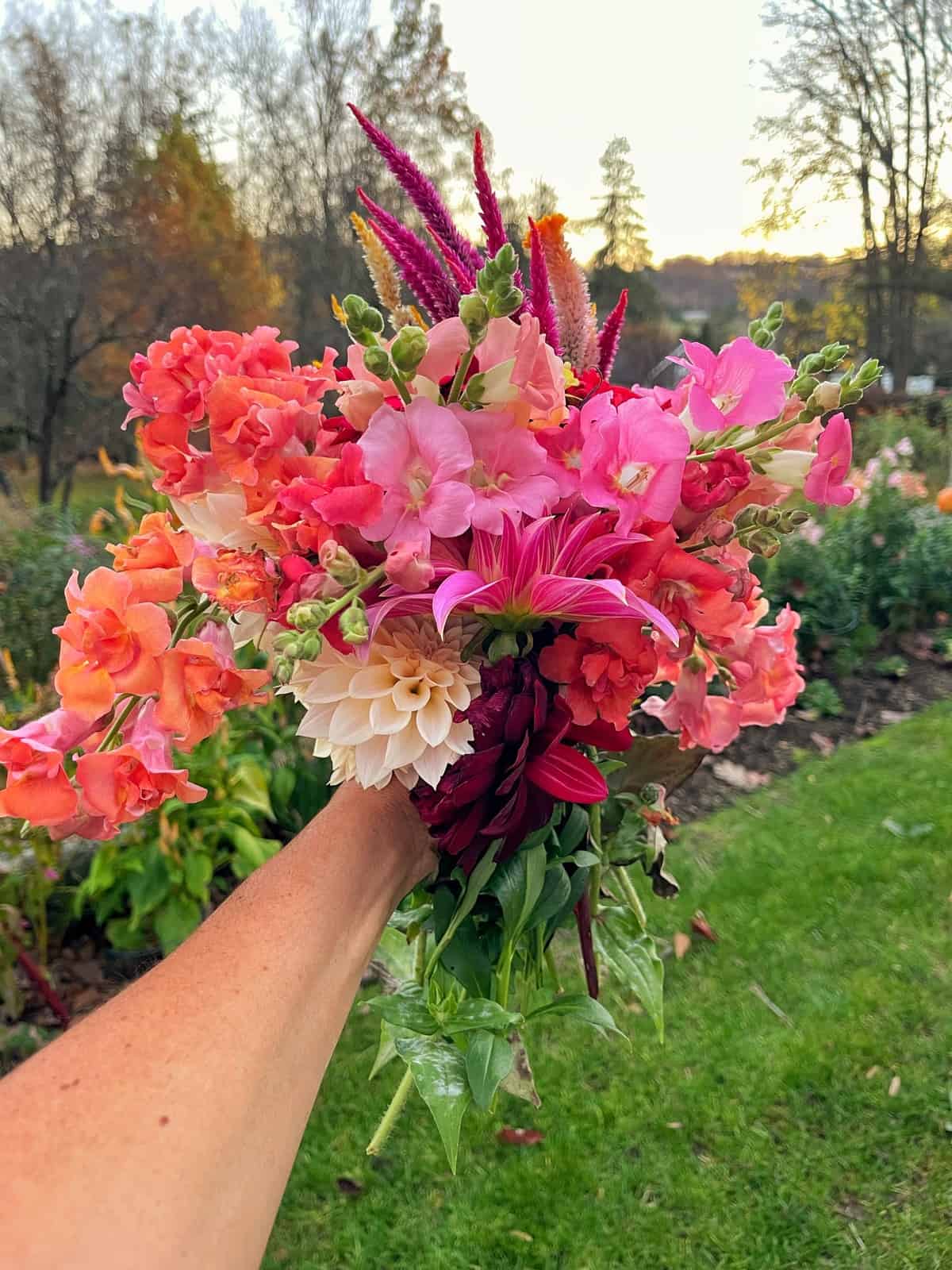
Beginner’s Guide to Planting Dahlia Tubers
You’ll most likely be shopping for dahlia tubers instead of full-grown plants. I usually order my dahlia bulbs online from reputable sources like Longfield Gardens and White Flower Farm.
But you can also find them at your local nursery; however, there won’t be as great of a selection. So I recommend you shop online.
Regardless of where you shop, it’s important to select healthy dahlia tubers that are plump, firm, and free from any signs of decay, mold, or damage. Choose tubers that have “eyes,” which are small buds or growth points on the tubers that will eventually sprout into stems and leaves.
Dahlias look best when planted in groupings. I usually go with three dahlia plants per variety and plant a few varieties in the same area of my garden. If you lack garden space, you can grow dahlias in pots. (See more below for more.)
Before planting dahlias, you’ll want to find the best location for them in full sun with well-draining soil. Conducting a soil test is a crucial step in preparing your garden for planting dahlias. A soil test helps determine the pH level and nutrient content of your soil, providing essential information for optimal plant growth. Kits are available at your local cooperative extension and garden nursery.
To conduct a soil test, collect soil samples from different areas of your garden and mix them together. Send the composite sample to a local extension service or use a home testing kit. The results will guide you in making necessary amendments, such as adjusting pH levels or adding nutrients, ensuring that your bearded irises have the best possible growing conditions.

How to Plant Dahlia Tubers: Step-by-Step Directions
Planting dahlia tubers is a pretty straightforward process. Here’s how to do it.
- Choose a spot in your garden that receives at least 6-8 hours of direct sun with well-drained soil. Dahlias prefer loamy, fertile soil with good drainage and are not fans of heavy clay soils. You can also amend the soil with organic matter, such as compost, or well-rotted manure, to improve its fertility and drainage. It’s also a good idea to add some leaf mold to help with moisture retention.
- When planting dahlia bulbs, a good rule of thumb is to dig a hole that is about 4-6 inches deep and wide enough to accommodate the tuber. Place the dahlia tuber in the hole with the “eyes” facing upwards, and cover it with soil. If you are planting multiple tubers, space them about 18-24 inches apart to allow for proper growth and airflow.
- After planting, water the tubers well.

When to Plant Dahlia Bulbs
The best month to plant dahlias depends on your location and climate. Dahlia flowers are typically planted in the spring after all danger of frost has passed and the soil has warmed. In most regions, this is usually in the late spring to early summer, when the soil temperature has reached around 60°F or higher. If you want to have a good gauge on the soil temperature, you’ll need to use a soil thermometer.
As a general guideline, in gardening zones 7 and above, which have milder winters, dahlia tubers can be planted in late April to early May. In colder regions, such as USDA Hardiness Zones 6 and lower, where the winters are harsher and the growing season is shorter, dahlia bulbs are usually planted in May to early June.
If you want to get a head start in early spring, plant dahlias in containers in a sheltered area like a garage or shed, and don’t water them. Leave them be until it is time to plant them outside.

A Guide to Dahlia Care
Now that you’re acquainted with the dazzling world of dahlias, let’s roll up our sleeves and delve into the practical aspects of their care. In the following sections, we’ll chat about how to keep them thriving.
Watering Dahlias
Dahlia flowers prefer consistently moist soil that is not waterlogged. Water deeply and regularly, especially during dry periods, to keep the soil evenly moist. It is best to water in the early part of the day. Avoid watering dahlia flowers later in the day or from above, as wet foliage can lead to fungal diseases. Watering at the base of the plant prevents water from splashing on the leaves and flowers.
Drip irrigation systems set on a timer are great for keeping dahlias well-watered throughout the growing season without the need for additional hand watering from you.
Because dahlia flowers are more maintenance than other plants, I recommend using a drip system if you can. It helps keep them hydrated, particularly during long hot, dry summers and it is set and forget.

Fertilizing Dahlia Flowers
The quality of your soil will determine if and when to fertilize dahlia flowers. If you add a soil amendment like aged manure, fertilizer is not needed when you plant. However, if composted materials like pine bark, leaf mold, peat moss, or something similar are used, then add about 1/4 cup of balanced fertilizer per plant.
After the first month, I recommend using a slow-release fertilizer so the application is set and forget and will make things easier for you during the remainder of the growing season.
Whatever method you choose, follow the specific package directions and do not apply more than recommended on the labeling. More is not always better when it comes to fertilizing.
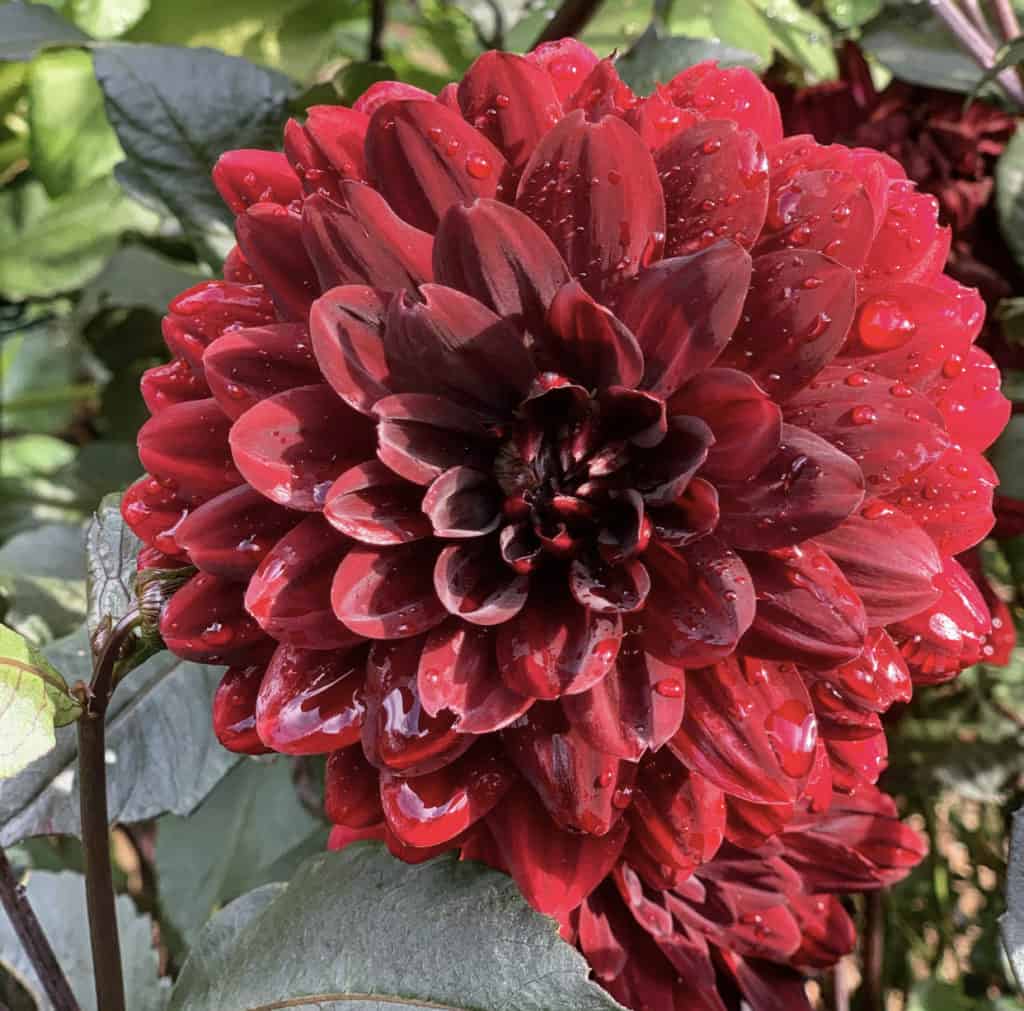
Pinching, Pruning and Deadheading Dahlia Flowers
Pinch back the tips of the stems when the plants are about 12-18 inches tall to encourage a bushier plant that will produce more flowers. Remove dahlia plant leaves and flowers that are dead or yellowing during the growing season to promote healthy growth and prevent disease.
And deadhead spent flowers so plants produce an abundance of blooms. Dahlias are cut-and-come-again-type flowers, so the more you cut, the more they will bloom. I like to use these garden snips or pruners when pruning or deadheading my dahlias.

Mulching Dahlia Flowers
Mulching around the base of the dahlia plants can help retain moisture, suppress weeds, and regulate soil temperature. Use organic mulch, such as straw, wood chips, or shredded leaves, and apply it to a depth of 2-3 inches. Organic mulches will help suppress weeds and eventually break down to enrich the soil. Avoid mulching too close to the stems to prevent rot.

Supporting Dahlias
Not all plants need support but there are many large dahlias that need help so the weight of the flowers don’t cause it to fall over. For those that require additional support, you can use:
I have not found individual plant stakes to be very effective with dahlias and prefer using something more substantial. Instead, I prefer trellis netting where possible. This method works best you are growing a dahlia garden in the same border. And I recommend doing two layers of it so you can space them out enough to stake the tallest of dahlia flowers.
For more information about supporting tall flowers, I shared a detailed post here recommending different options.

How to Grow Dahlias in Pots
Growing dahlias in pots are a popular option for gardeners who have limited space or want to add a burst of color to outdoor living spaces where planting in the ground is not feasible. For best results, here’s what you need to know to grow dahlias in pots.
- Choose a container with a diameter of at least 12 to 16 inches and a depth of at least 12 to 18 inches. Make sure the container has drainage holes to allow excess water to escape and prevent waterlogging.
- Use a well-draining potting mix. You can also add perlite, vermiculite, or sand to the potting mix to improve drainage.
- Plant one dahlia tuber per container, positioning it horizontally with the “eye” or bud facing up. Cover the tuber with about 2 inches of potting mix.
- Maintain containers in full sun with at least 6 hours of direct sunlight per day. Rotate the container periodically to ensure even sunlight exposure on all sides of the plant.
- Containers dry out faster than the ground, so it’s important to water them regularly, checking the soil moisture level with your finger or a moisture meter. Avoid overwatering, as soggy soil can lead to root rot. Allow the top inch of soil to dry out slightly between watering.
- Fertilize dahlias with a balanced water-soluble fertilizer formulated for flowering plants and follow the package instructions for application rates and frequency.
- Stake or cage plants to provide support as they grow, being careful not to damage the tubers or roots during the process.
- In colder climates, dahlias will need to be dug up and overwintered indoors if you want to enjoy the following season.

Protecting Your Dahlias: A Guide to Pest and Disease Prevention
Dahlias can be tough to grow and suffer from many problems including aphids, leafhoppers, slugs, and caterpillars. Potential diseases include powdery mildew, root rot, crown gall, viruses, and wilts.
For best care, walk your gardens every day and check on your dahlia plants. Look for any signs of problems or infestations that need to be addressed. If need be, insecticidal soap or neem oil can be used depending on the problem.
It is a good idea to wear garden gloves when working with dahlias because they can cause contact dermatitis in some people with sensitive skin. I haven’t had that problem before, but know a few people who have.
Good air circulation and proper spacing between dahlia plants can also help prevent pest and disease problems. So be sure to give them the proper spacing when planting.

How to Store Dahlias for Winter: Tips for Keeping Tubers Healthy
In areas with cold winters, dahlias are typically treated as tender perennials and need to be protected from frost. My gardening zone 6b, is one of them. So if you want to save your dahlias so they bloom again next season, you’ll need to dig them up and store them for winter.
After the first frost, tag and label each dahlia so you know what’s there. Then cut back the foliage to about 2-3 inches above the soil level, carefully dig up the tubers, and store them in a cool, dark place where the temperature remains above freezing but below 50°F.
Allow the tubers to dry for a few days before storing them in a well-ventilated container with peat moss, vermiculite, or dry sand. To learn more about how to dig up and store dahlias for winter, check out this post.

Dividing Dahlia Tubers
Dahlia tubers can multiply over time, and dividing them every 2-3 years can help rejuvenate the plants and promote better flowering. Dividing dahlia tubers is typically done in the spring before planting, and it involves carefully separating the tubers with a sharp, clean knife, making sure each division has at least one “eye” or bud.
If you overwintered your dahlias, when you take them out of storage, carefully inspect them for signs of rot or disease before dividing them.

Why Dahlia Flowers Are Not Considered Easy Care Plants
While I am a huge fan of growing dahlias because they are beautiful and rewarding plants to grow, they are not considered “easy-care” plants for several reasons. So before growing them in your garden, carefully consider whether you want to do the work involved so you can be more successful with them.
- To grow dahlia flowers the following season, the overwintering process is a lot of work to keep them alive and prevent tubers from rotting and drying out.
- Dahlias have specific growing requirements that need to be met for optimal growth and flowering.
- Dahlias require some pruning and staking to maintain their shape, prevent flopping over, and encourage bushier growth.
- They are more susceptible to pests such as aphids, spider mites, and slugs, as well as diseases like powdery mildew and botrytis.
- Dividing tubers can also be a bit tricky, as it requires separating them without damaging the delicate “eyes” or buds that will sprout new growth in the next growing season.
What to Keep in Mind
Despite these challenges, many gardeners find the effort and care required to grow dahlias to be worthwhile for their stunning blooms. From my experience, they are definitely more work than other plants, but pretty easy to grow once you learn how to do it and what works best for you.
I will say, it would not have been a good flower for me to grow while I was running around with three kids. But it’s perfect for me to grow now that they are older and don’t need as much time from me.

Why Dahlias Are the Perfect Cut Flowers for Your Home
Dahlias make excellent cut flowers for floral arrangements. Here are some tips to get the most out of these flowers in a vase.
- It’s best to harvest them when they are in the “soft” or “half-open” stage of bloom. At this stage, the flowers are mature but not fully open, and they will last longer in a vase compared to fully open flowers.
- To extend their vase life, harvest in the early morning or late evening when the temperatures are cooler. Avoid harvesting during the heat of the day.
- Use sharp and clean tools to ensure clean cuts and minimizes damage to the stems, which can improve water uptake and prolong vase life.
- Remove any foliage that will be under the waterline to prevent rotting and bacterial growth.
- Once cut, immediately place the dahlias in a bucket of clean, tepid water. Let them rest for a few hours or overnight to allow them to fully hydrate and condition before arranging them in a vase.
- Change the water regularly every 2-3 days, and recut the stems at an angle to ensure they can continue to take up water. This helps prevent bacterial growth and keeps the flowers fresh.
- Place the vase of dahlias in a cool spot away from direct sunlight and drafts, as these can cause the flowers to wilt more quickly.
- Feed the blooms with flower food. If you don’t have any on hand, you can make your own homemade flower food with this recipe.
Play around with your blooms and experiment with different color combinations, textures, and vase styles to create visually stunning displays. To learn how to arrange flowers like a pro, click here. And for more information to keep fresh cut flowers longer, click here.
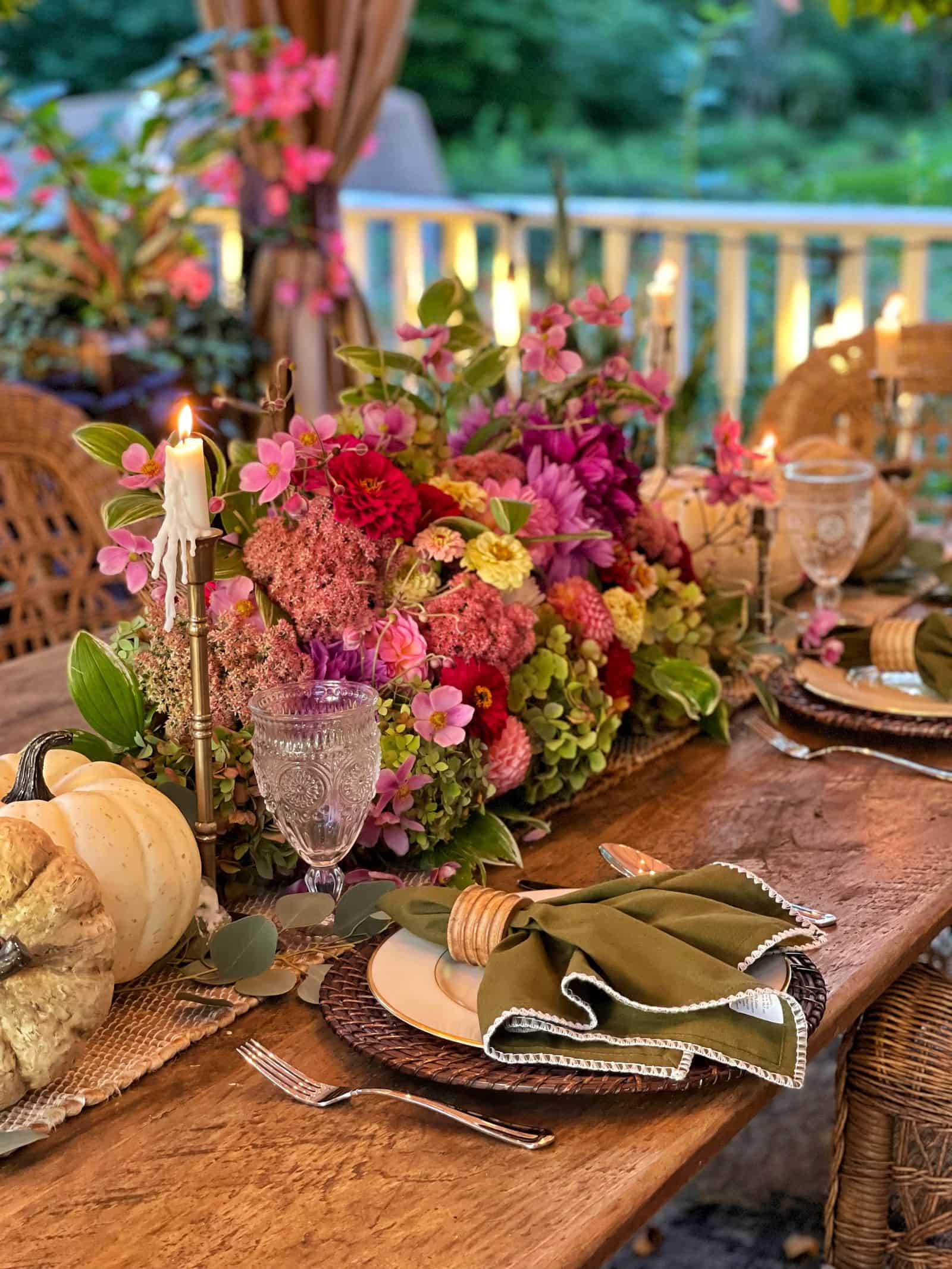
My Favorite Varieties of Dahlias
Having grown them for several years now, there are a number of dahlia varieties that I love. Here are some of my favorites:
- ‘Jowey Winnie’
- ‘Penhill Watermelon’
- ‘Cafe Au Lait’
- ‘Thomas Edison’
- ‘Eveline’
- ‘Labrynth’
- ‘Tropical’
- ‘Karma Choc’
- ‘Pooh’
- ‘Bonanza’
- ‘Urchin’

Dahlia Flowers FAQs
Do Dahlias Come Back Every Year?
As mentioned before, dahlias are tender perennials which means they are not reliably winter-hardy and may not come back every year in colder climates or areas with harsh winters. However, in warmer regions or in well-protected microclimates, dahlias may survive and regrow from tubers left in the ground over winter.
In colder climates where temperatures drop below freezing, dahlia tubers need to be lifted and stored indoors during the winter to protect them from frost and prevent them from rotting if you want to grow them the following year.
And if your region is on the cusp, you can try heavily mulching during the winter to see if you can encourage dahlias to return the following season without digging them up.

Do Dahlias Do Better in Pots or in the Ground?
Dahlias can be grown successfully both in pots and in the ground, and the choice between the two largely depends on your specific gardening situation, space availability, and personal preferences. Here are some considerations to help you decide whether dahlias may do better in pots or in the ground.
Try Growing Dahlias in Pots If:
- If you have limited space.
- They are more portable so you can move them around to optimize sunlight exposure or for aesthetic purposes.
- You have more control over soil and drainage:
- They offer better protection from common pests like slugs, snails, and ground-dwelling insects, as they are elevated off the ground.
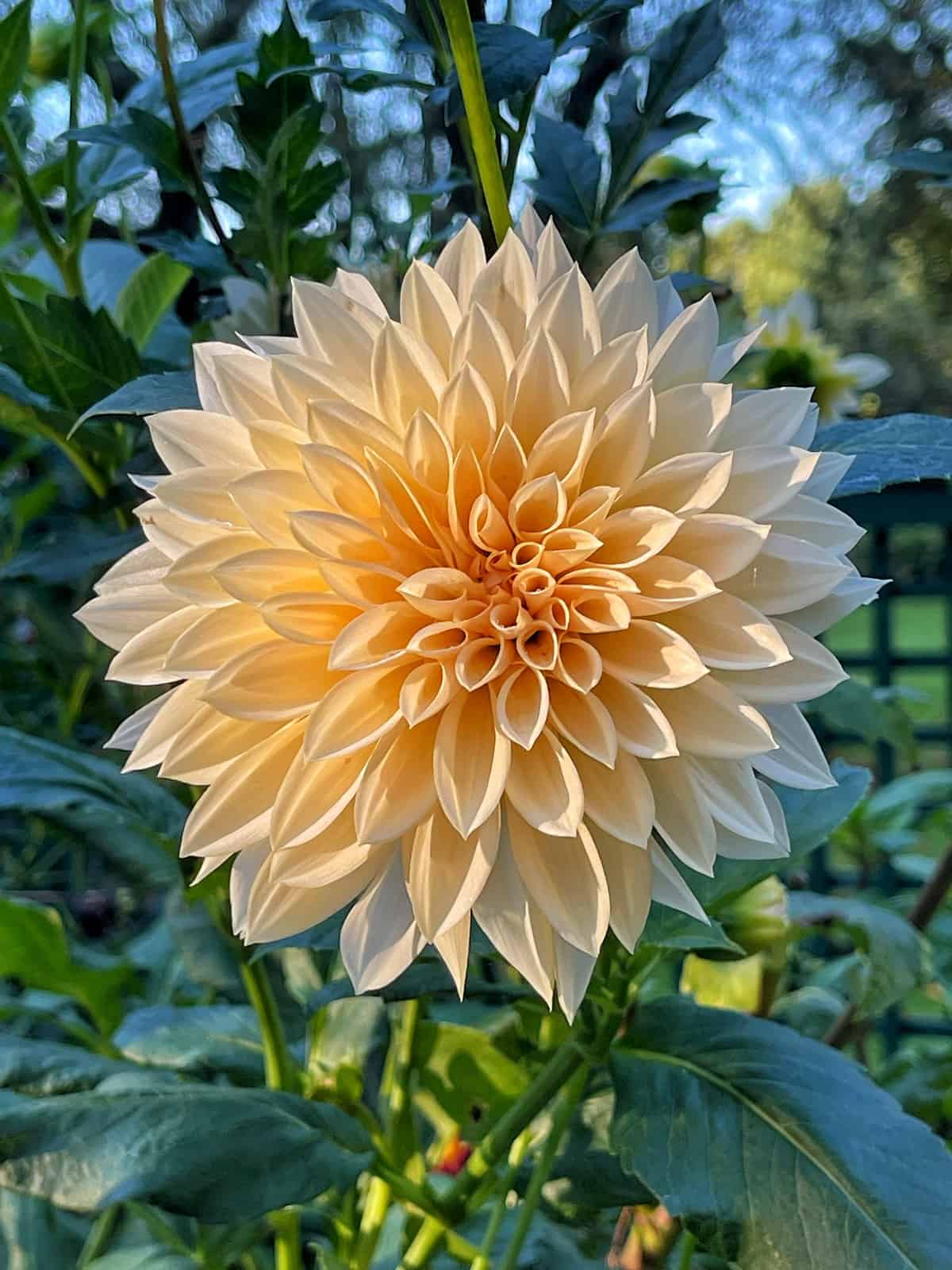
Plant Dahlias in the Ground If:
- Dahlias planted in the ground can benefit from the natural nutrients and microbial activity in the soil, which can contribute to healthier root development and overall plant growth.
- Dahlias planted in the ground can develop a more extensive and established root system compared to those in pots, which can enhance their stability and resilience against weather fluctuations.
- Some dahlia varieties can grow quite large, with tall stems and wide-spreading foliage. Planting these larger varieties in the ground provides them with ample space to grow and develop to their full potential.
- There is less watering maintenance as pots dry out more quickly than in the ground.
In general, dahlias can thrive both in pots and in the ground, and the decision on whether to grow them in pots or in the ground depends on your specific gardening situation and preferences.

Are Dahlias Deer Resistant?
While there are lots of flowers that are deer-resistant, dahlias are unfortunately not one of them. If deer are a problem in your area, your dahlia flowers will need protection. There are lots of different ways you can protect your dahlia garden from deer damage. So choose what method works best for you.
I grow mine in my potager garden that is fenced in. If you don’t have a fenced in area, using deer repellents are a great option.
I am partial to this deer repellent that is systemic as well as this one that I’ve been using for as long as I can remember. Both work extremely well and I highly recommend them if you battle deer with your garden flowers.

Final Thoughts About Growing Dahlias
As we’ve journeyed through the world of dahlias, it’s clear that these stunning blooms offer both rewarding challenges and breathtaking beauty. While they may require a bit more attention than some other flowers, the payoff is undeniable. With their vibrant colors, unique shapes, and long blooming season, dahlias are a true treasure for any garden.
By following the tips and tricks outlined in this guide, you’ll be well on your way to cultivating a thriving dahlia haven. Remember, gardening is a journey of learning and experimentation. Embrace the process, don’t be afraid to get your hands dirty, and most importantly, enjoy the fruits of your labor as you watch your dahlias grow and bloom.
Whether you’re a seasoned gardener or just starting out, growing dahlias is an adventure that’s sure to bring joy and fulfillment.
If you have any questions, comments or suggestions, please let me know in the comments below. I’d love to chat more!
Happy gardening!
For more information about how to grow dahlias see:
To drill down on more beginner gardening techniques and tips, please read these post:
Thank you so much for following along.
Enjoy a beautiful day! xo
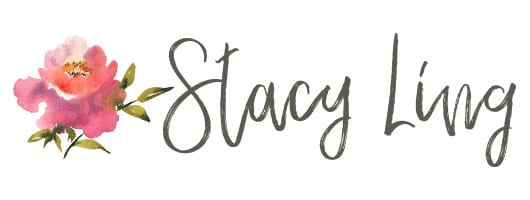

Want to Learn More About Growing Dahlias?
- How to Grow Dahlias
- Must-Have Dahlia Varieties for Your Cut Flower Garden
- Planting Dahlias Tubers Like a Pro
- How to Overwinter Your Dahlia Tubers
- A Guide to Growing Dahlias in Pots









